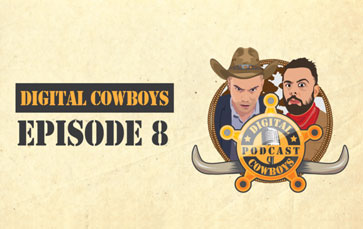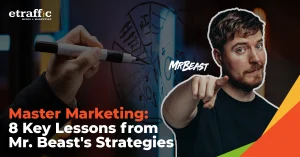![]() Posted by Cameron Francis
on
20 Jun , 2017
in
Posted by Cameron Francis
on
20 Jun , 2017
in

Learn how to increase your website traffic through video content! Master the art of optimising videos for YouTube with Cameron Francis and Sam Roshan as they discuss how to use tags wisely, create strong call to actions and develop video concepts based on customer value, including pro-tips for small to medium business owners. Tune in to learn more in this episode of The Digital Cowboys.
Show Notes:
- Keyword Research – 00:02:03:27
- Keyword Tool.io – 00:03:38:19
- YouTube Video Maker – 00:04:50:11
- Create an Optimised Title – 00:06:05:14
- Use Tags Wisely – 00:08:11:12
- Create a Full Description – 00:08:54:10
- Create a Strong Call to Action – 00:10:51:08
- Develop Video Concepts Based on Customer Values – 00:12:44:06
- Repurposing Video Content – 00:13:40:25
Transcript
|
Sam Roshan: |
Let’s talk about, when you’re creating videos, what are the things that you |
|
|
want to consider. One of them is actually doing some keyword research. |
|
Sam Roshan: |
It’s actually create the topic and the video that you want to put together. |
|
|
You really want to be able to see what people are actually searching for, so |
|
|
create the videos around search-based queries. |
|
Cameron Francis: |
Take the time to write it out to explain what the video is about. At the very |
|
|
top of the description, I would generally write, “For more information, go |
|
|
to URL,” and that URL would be our website, or in a page, it’ll be our |
|
|
contact details plus the people. |
|
Voice Over: |
Digital Cowboys Episode 8. |
|
|
We discuss everything digital marketing and growth hacking for small |
|
|
businesses, startups and entrepreneurs. If you want that competitive edge, |
|
|
then saddle up because Cameron Francis and Sam Roshan are about to |
|
|
drop some value bombs. |
|
Cameron Francis: |
Hey, everybody, this is Cameron Francis … |
|
Sam Roshan: |
And you’re with Sam Roshan. |
|
Cameron Francis: |
… and this is the Digital Cowboys. |
|
Sam Roshan: |
Cowboys. |
|
Cameron Francis: |
Right on. How are you today, Sam? |
|
Sam Roshan: |
There are so many things that I would want to replace ‘Cowboys’ with, and |
|
|
I find just really funny. |
|
Cameron Francis: |
What’s one? |
|
Sam Roshan: |
There’s thing I want to mention. We’ll just stick to Cowboys. |
|
Cameron Francis: |
What do you want to talk about today? |
|
Sam Roshan: |
I think today we have a pretty good and interesting topic, which is |
|
|
optimizing videos for YouTube. |
|
Cameron Francis: |
Love it. We all know who YouTube is. It is the … Is it the number one search |
|
|
engine, or is it number two? It’s one or two. |
|
Sam Roshan: |
Yeah, it’s top two and they’re both owned by the same people. |
|
Cameron Francis: |
Owned by the same people. YouTube’s massive, so many people are using |
|
|
it, watching it, all walks of life. You can use it as a really effective marketing |
|
|
tool and also you can siphon from free traffic for people that are looking for |
|
|
how-tos about your business, etc, etc. |
|
Sam Roshan: |
And it is the world’s second largest search engine. |
|
Cameron Francis: |
Kaboom. |
|
Sam Roshan: |
Just Google it. |
|
Cameron Francis: |
Let’s just start with all the value. Number one, what would you want to do? |
|
Sam Roshan: |
Let’s talk about when you’re creating videos, what are things that you want |
|
|
to consider. One of them is actually doing some keyword research. It’s |
|
|
actually create the topic and the video that you want to put together. You |
|
|
really want to able to see what people are actually searching for, so create |
|
|
the videos around search-based queries. |
|
Cameron Francis: |
How would you do that? |
|
Sam Roshan: |
One of the easiest ways to do this is just to go to google.com.au and just |
|
|
look at how-to, what and basically look at keywords around your industry |
|
|
and the how-to and the whats and the why. Google will start preempting |
|
|
the queries that people have been asking about. Also if you wanted to like, |
|
|
for example, talk about dental fillings, because I just one done today … |
|
Cameron Francis: |
Very good. |
|
Sam Roshan: |
… so Google |
|
Cameron Francis: |
So if people are wondering why he’s talking a little bit funny, and he’s |
|
|
actually salivating from his mouth, it’s because he went to the dentist. |
|
Sam Roshan: |
I am not. That’s all bollocks, but that’s cool. When you’re looking at dental |
|
|
fillings, if you just scroll down on the search results on Google search |
|
|
results, so you’ll be able to see all the related search terms. |
|
|
The easiest way, and there’s multiple ways of doing this, so you can also |
|
|
use Google Keyword Planner Tool. But I think to just make it really easy, |
|
|
Google just really is trying to, and has been always wanting to provide the |
|
|
most relevant search results for the end-user, and they do that, so it makes |
|
|
it really easy for you to do your keyword research. Just Google it. |
|
|
The other one is you’ve got plug-ins like the KeywordsTool.io. Cameron, |
|
|
maybe if you want to just share a little bit about KeywordTool.io. |
|
Cameron Francis: |
All right. KeywordsTool.io. It’s a tool that we use for our SEO clients to find |
|
|
money keywords, good keywords, keyword research, keyword volume, |
|
|
competitiveness. It’s really good. There’s a few tabs in there you can use to |
|
|
get Bing, obviously, Google, and there’s a tab for YouTube. A lot of them |
|
|
are going to be question-based queries. So, your ‘what, where, how, when.’ |
|
|
I liked your idea of going to Google. I like the fact that you can interpret the |
|
|
information then it gives you on the SERPs. Let’s just say we do SEO, all |
|
|
right. So what? SEO. What is SEO? Easy. Where? Where SEO. Where should |
|
|
you do SEO? Why? Easy. Why should you do SEO? |
|
Sam Roshan: |
Where you should do SEO. |
|
Cameron Francis: |
Where should you do SEO? Country-based. Should you do SEO overseas? |
|
|
The intent’s the same even if the question is a little bit different, but you |
|
|
just got to be smart enough to be able to tailor that yourself, so, yeah, |
|
|
keyword research, absolute must if you’re wanting to get as much traffic as |
|
|
possible. What else have we got? |
|
Sam Roshan: |
YouTube Video Marker. It’s quite self-explanatory. There is multiple tools |
|
|
out there that actually you can go online and search for this. There’s a lot of |
|
|
types of softwares that you can actually create your videos from or edit |
|
|
them. It makes it a lot easier and it is quite cost-efficient, and it’s a fantastic |
|
|
way for you to be able to get the ball rolling. |
|
|
One of the things that a lot of businesses always struggle with and I know |
|
|
that all the gurus mention that today it’s execution. You might have all |
|
|
these ideas and you want to do things. It becomes overwhelming and |
|
|
there’s so many tasks to do throughout the day. We get it. It happens to all |
|
|
businesses, especially when you’re small to medium size because you’ve |
|
|
got so many hats on. |
|
|
At the end of the day it’s just something that you have to do because the |
|
|
world is becoming a competitive space. There’s so much content being |
|
|
pushed out there and if you’re not producing any valuable content as part |
|
|
of the value proposition that every business ideally should have, and |
|
|
YouTube Video Maker, it makes it easier. You want to do this as |
|
|
cost-efficiently as possible. It’s a way to be able to do your videos and |
|
|
there’s a lot of good, easy tools that you can use. |
|
Cameron Francis: |
Very good. |
|
Sam Roshan: |
What’s next? |
|
Cameron Francis: |
The title. It’s obviously the first thing that gets seen. On the actual video |
|
|
itself, I would optimize the title to make sure, first of all, it’s catchy and it |
|
|
explains what the video is, but it doesn’t hurt to actually make it |
|
|
keyword-rich, right? If you’re targeting, “What is SEO?” that’s going to be |
|
|
the title of the actual video itself, “What is SEO?” You put your own brand |
|
|
name in there as well, so you want to put a straight line, and then, put the |
|
|
business name so that you’re able to target both of them. Utilizing your |
|
|
keyword research, you find the most searched phrase, and that’s generally |
|
|
going to be the title of the YouTube video. |
|
Sam Roshan: |
Very cool. What I just did is I just typed in “How to lose weight fast,” for no |
|
|
apparent reason, just to find out- |
|
Cameron Francis: |
Because you’re vain. |
|
Sam Roshan: |
… What was that? |
|
Cameron Francis: |
Because you’re vain? |
|
Sam Roshan: |
Because I am vain, probably. Just to find out, I guess, looking at some of the |
|
|
titles that are being created. What I did is actually just jumped on to page |
|
|
10 and the second listing there, the title states “Quick Sweats Cardio |
|
|
Workout to Lose Weight and Burn Belly Fat Fast.” Looking at the first |
|
|
listing, the first listing is giving us … what is the title? “How to Lose Weight |
|
|
Fast, 10 Kilos in 10 Days,” so just doing a comparison between the two. |
|
|
Although their intent is the same, one is straight to the point, but also, |
|
|
obviously, it’s ranking quite well. It’s got all the … |
|
Cameron Francis: |
For example, I’ll give you some examples that we’ve done. If you actually |
|
|
search for Anzac Day, kablammy, our video appears number one, 80,000 |
|
|
viewers. “What is Anzac Day?” question, targeting that keyword by |
|
|
ETRAFFIC and there’s a few more. Like if you type in “web design |
|
|
Melbourne,” we’ve got videos there. The idea, make sure that you’ve got |
|
|
the question inside the extra title and you want to reference your business |
|
|
name and what you just mentioned as well. |
|
Sam Roshan: |
Great. |
|
Cameron Francis: |
What else you got? |
|
Sam Roshan: |
Tags. |
|
Cameron Francis: |
Tags are very important. |
|
Sam Roshan: |
Very important. You got to use them wisely, really consider who you’re |
|
|
trying to target, what they are going to be searching and so on. Just make |
|
|
sure that the tags are really relevant, and just don’t go nuts. You have to |
|
|
really be concise with what your tags are, and just keep it uniform |
|
|
throughout all your videos that you produce. |
|
Cameron Francis: |
Hashtag pro tip: What I like to do is use competitor channel names and |
|
|
competitor names as tags so that when people are searching for them, our |
|
|
video appears. It does work. Give it a crack. |
|
Sam Roshan: |
Very good. Very good. |
|
Cameron Francis: |
All right. Next, the actual description itself. There’s a couple of things I like |
|
|
to do here. With the description, take the time to write it out, to explain |
|
|
what the video is about. At the very top of the description I would generally |
|
|
write, “For more information, go to URL,” and that URL will be our website, |
|
|
or in a page, it’ll be our contact details plus some people. If they want to |
|
|
call or contact or make an inquiry, they’ll be able to go through there as |
|
|
well. But the description underneath that is all going to be the value that |
|
|
the video gives. |
|
|
I’ll also have some links embedded so links within the actual description |
|
|
itself … |
|
Sam Roshan: |
Always. |
|
Cameron Francis: |
… so that people can go through to those particular pages. Yeah, I think |
|
|
that’s about … and a call to action at the end, so it’s a typical description. |
|
|
Like you just go through some videos … |
|
Sam Roshan: |
…closed captions. Even if you only upload is transcripts … |
|
Cameron Francis: |
Yup, yup. Well, with the transcript, that’s a must. Because what people can |
|
|
do is they can get your video, they can see if the content is in written form |
|
|
on Google, and they can actually get the transcript of your video, and then, |
|
|
claim as their own content, right? So if you’re not uploading the transcript |
|
|
or the actual content on your website itself, then you don’t get the actual |
|
|
written value that Google can bring. |
|
|
What we do is we got a website called Rev.com. Some of our videos are |
|
|
pretty long, right, so they’ll actually transcribe this audio for us. I’ll upload |
|
|
the audio and for an hour audio, it will cost us 15 bucks, but can you |
|
|
imagine sitting through listening and writing it out how much that would |
|
|
cost from a time perspective? So I use that, and then, based on that, we |
|
|
will upload it into YouTube and make sure that it’s on our website as well. |
|
|
Website gets the benefits from an SEO perspective. |
|
Sam Roshan: |
Also, an example is something that Cam mentioned earlier with regards to |
|
|
call to actions, like, share, comment, subscribe to our channel. Just real |
|
|
simple things, but very effective. |
|
Cameron Francis: |
On that actual video itself, I would make sure that I am at the very end. I’ll |
|
|
have the still frame of the video, and you can use that as an outro, so a still |
|
|
frame and on that still frame it’s going to have links embedded to all the |
|
|
social channels. It’ll have an arrow pointing to “Subscribe to our page.” |
|
|
It will have “Watch the next episode,” and then embed the video that you |
|
|
want them to watch after the current video right on that screen. That’s all |
|
|
on maybe 10, 15 seconds on the still frame, but utilizing that time because |
|
|
people are on your page, they’re ready to go through more content. This |
|
|
will make sure that you get more engagement. |
|
Sam Roshan: |
Cool. |
|
Cameron Francis: |
The other thing that I would add would be making sure that you have a |
|
|
really strong call to action. At the end of the video, you’ve got to think … |
|
|
Sorry, let’s go back. You’ve created this video for a purpose. You’re |
|
|
satisfying someone’s need. They have a question, they have a problem, |
|
|
you’re providing that solution. Once you’ve provided that solution, what do |
|
|
you think they want next? What should they do? Should they contact you? |
|
|
Should they go to another video? Should they subscribe? Whatever it is, |
|
|
make sure that you’re putting that into the video at the very end, and |
|
|
that’ll improve the actual conversion rates just by asking. |
|
Sam Roshan: |
Excellent. Something that you just mentioned before is think about what it |
|
|
is that they should do next, so really we’re talking about tailoring every |
|
|
single video and the whole process of uploading it and so on, towards the |
|
|
need of the audience. |
|
|
Taking it a couple of steps back and actually creating the video itself, it has |
|
|
to be concept-based. What that would look like is it really should be |
|
|
revolved around how it’s going to provide value to your audience and to |
|
|
your potential customers. So really think about, and if you’ve been |
|
|
operating for a while, I’m sure there is a whole lot of questions that people |
|
|
come and ask you all the time. |
|
|
You can again use Google to find out what people are searching for and |
|
|
create the content around that. Create the video and ensure that there is |
|
|
enough value in it for them to want to provide that like, or want to share |
|
|
this video, or want to watch the next video. Because there is just so much |
|
|
content out there everyone is so busy doing something, nothing, whatever |
|
|
it may be, but people are quite busy and we’re asking for their time. How |
|
|
do we ensure that there is enough value for them to want to continue and |
|
|
take the next step? |
|
Cameron Francis: |
Love it. Last one, repurposing, and I’ll let people in as to how we’re going to |
|
|
or how we are repurposing all of this content now. We’re recording a |
|
|
podcast that people are listening to. We are also video-recording the |
|
|
podcast using this audio so that we can upload that into YouTube. We will |
|
|
get the transcript of this and create a long-form article on the same topic. |
|
|
We will then use the key points of this and create an infographic of this |
|
|
very talk on how to optimize a YouTube video. We will Facebook Live, sorry, |
|
|
you can Facebook Live it. You can Instagram Live it. |
|
|
Oh, there’s one more also with Instagram. Now that you’ve got the ability |
|
|
to have 10 slides, you can actually cut up the video that we are recording |
|
|
now into 10 one-minute slides. You edit it based on titles, and then, people |
|
|
can watch the actual video. You’re going to have 10 videos in one, so |
|
|
10-minute video broken up into slides, and you can repurpose that |
|
|
information that way. Saves you a lot of time, and you are able to get more |
|
|
reach out of there, whether people like to listen, whether people like to |
|
|
watch, or people like to read. |
|
Sam Roshan: |
What you just mentioned before, everything sounds great. To some of the |
|
|
audience, oh, anyone that’s actually listening to this, it might be a bit |
|
|
overwhelming looking at there is just so much that you can do with just |
|
|
one, this particular type of content. You don’t have to do all of them. We’re |
|
|
providing ideas for yourself, for people to consider. Even if you pick one or |
|
|
two of them, there’s just multiple ways of doing this and just see what your |
|
|
audience prefers best and test it. You don’t have to do all of it. These are |
|
|
just there for everyone. I guess new ideas. |
|
Cameron Francis: |
Yup, yup. |
|
Sam Roshan: |
Really |
|
Cameron Francis: |
I really like this, but you know what I really like, Sam? I like Halal snack |
|
|
pack, my friend. |
|
Sam Roshan: |
I know. It’s getting cold and I’m very hungry, too. |
|
Cameron Francis: |
I’m done. |
|
Sam Roshan: |
All right. Cool. |
|
Cameron Francis: |
Thanks for tuning in, guys. |
|
Sam Roshan: |
See you. |
|
Voice Over: |
Thanks for listening to the Digital Cowboys with Cameron Francis and Sam |
|
|
Roshan. Now, if you enjoyed today’s episode, head on over to iTunes and |
|
|
give us a five-star rating and, please, write a review. Also, head on over to |
|
|
digitalcowboys.com.au where we post the latest episodes and content |
|
|
pieces for all of our listeners, so saddle up and join us next time for another |
|
|
edition of the Digital Cowboys. |






